The Marine is the king of voodoo. How an American sergeant became the monarch of the Haitian island
From Poland to Haiti through Pennsylvania
When 16 in November 1896 was born in the small town of Rypin in the Kingdom of Poland, then part of the Russian Empire, a boy was born, whose name was Faustin Virkus, his parents could hardly guess that he would be destined to enter the world after some three decades. history as king of the haitian island. It is possible that if the Virkus family lived in Poland, then its younger offspring would only read about Haiti in geography books. But when Faustin was still very young, his parents emigrated to the United States of America. Then, at the beginning of the twentieth century, from overpopulated and poor Poland, where it was difficult to find work, many young and not very people left for the United States, Canada, and even Australia — in search of a better life. The Vircus couple were no exception. They settled in Dupont, Pennsylvania. Since the family of Polish émigrés was not rich, since 11 years, Faustin, now called Faustin in English, had to earn a living on his own. He got a job at sorting coal — hard and dirty work. Perhaps it was precisely this that predetermined his further fate. At 12, teenager Fostin Virkus met a US Marine soldier who served outside the United States and talked a lot about sea cruises. After that, the boy did not leave the dream - to become a marine himself. But since Faustin was still very small for service, he continued to work in the coal mine. By the way, this work tempered him both physically and morally - just what the future marines need.
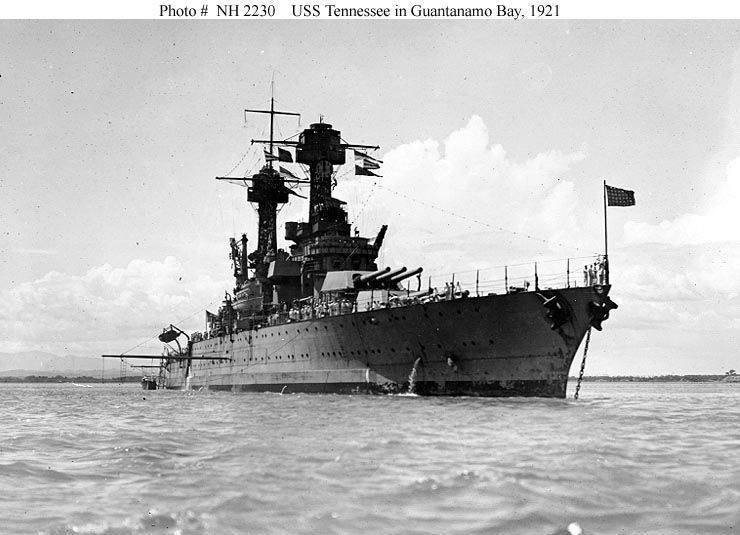
In February, 1915, eighteen-year-old Faustin Virkus, without even warning his parents, went to the recruiting office and achieved his dream - he was enrolled in the United States Marine Corps. During these years, the marines were the main instrument of American influence in the nearby Caribbean countries. From time to time, marines had to advance to combat missions in the countries of Central America and the Caribbean islands — to protect pro-American or overthrow anti-American regimes, curb riots, suppress rebellions of locals disgruntled by exploitative operations. However, the combat missions of the Marine Corps could be called a stretch - after all, the local weak armed formations resisted with well-armed and trained US marines, with almost no training and outdated weapons. For the most part, the marines performed police functions — guarding buildings, patrolling streets, and detaining opposition activists. In the summer of 1915, Marine Faustin Virkus on the battleship USS Tennesse, along with other colleagues, was taken to Haiti.
The cause of the landing of American troops in Haiti was the riots of the country's population, which erupted after another rise in prices and the deterioration of the already deplorable economic and social situation of the inhabitants of the country. Haiti is the first sovereign state in Latin America to declare political independence from France on January 1 1804. The overwhelming majority of the population of Haiti have always been negros - descendants of African slaves who were exported to the Caribbean from West Africa, from modern Benin and Togo. There was also a small stratum of mulatto, who differed from the blacks, first of all, by greater education and better economic position. Indeed, in the colonial era, the French planters were the ones who trusted the mulattoes to perform the functions of managers, small clerks and supervisors on plantations. Confrontation between mulattoes and blacks is typical of the entire postcolonial Haitian history. By the beginning of the twentieth century. Haiti was an extremely unstable politically and absolutely impoverished state. The arbitrariness of the authorities, corruption, banditry, endless riots and military coups, the exploitation of island resources by American companies — all of these negative phenomena were the hallmark of the state. Periodically, people tried to rebel against particularly hated rulers, however, unlike the Spanish-speaking countries of Central and South America, popular uprisings in Haiti never led to the establishment of more or less fair political regimes. Perhaps this was based on the specifics of the Haitian mentality - the descendants of African slaves were illiterate or illiterate and very dependent on belief in mysticism, miracles, and the supernatural capabilities of their leaders. In fact, Haiti is “Africa in America.”
American occupation of Haiti
The political history of Haiti after the proclamation of independence was characterized by the constant struggle of the mulatto minority, which nevertheless possessed considerable financial and organizational resources, and the black majority, dissatisfied with the exploitation of the mulatto. The fact is that before independence was declared, all power in the colony of San Domingo belonged to white colonists, the French and the Spaniards. Mulatas occupied secondary positions. They were forbidden to wear swords, enter into marriage relations with whites, but they enjoyed personal freedom and could have private property, including real estate and land. By the beginning of the 19th century, no less than a third of all plantations and a quarter of all African slaves of San Domingo were in the hands of wealthy mulattoes. At the same time, the mulatto as slave-owners were even more brutal than the whites, since they did not bother with the assimilation of the philosophical theories of the Enlightenment that were popular at that time, and were very superficial about the tenets of the Christian religion. The mulattoes themselves were divided into several categories. Mustiffs were the closest to white — those in whose veins only African African 1 / 8 (that is, whose great-grandfather or great-grandmother were blacks) flowed. Then came the Quarterons - на Africans, half-Africans - half, griffs - на Africans and Marabou - Africans on 7 / 8. Below the mulattoes on the social ladder of the Haitian society were free negros. Although among the liberated Negroes, there were a number of plantation owners and managers, but mostly they were engaged in crafts and trade in the cities of the colony. Another category of the Haitian population were the descendants of the Maroons — runaway slaves who took refuge in the inland areas of the island and created their settlements there, occasionally making raids on plantations with the aim of plundering and seizing food and weapons. The most famous leader of the Maroons was Makandal, a Guinean slave by birth, who managed for seven years, from 1751 to 1758. make armed raids on plantations and cities. Makandal sent voodoo cults and advocated the complete destruction of all the white and mulatto on the island. 6, thousands of people, mostly European planters, administrators and their families, were the victims of Makandal and his associates. It was only in 1758 that the French colonial forces managed to seize and execute Makandal. The confrontation between the mulattoes and the blacks continued even after a century and a half after the suppression of the Maronian uprisings. Periodically, the Negro majority rebelled against the mulatto elite, often politicians of a populist role played in this confrontation, seeking to enlist the support of the Negro majority and playing on the mutual dislike of the two groups of the Haitian population. The second half of XIX - early XX centuries. for Haiti - a continuous series of upheavals, uprisings and changes of governments and presidents. It should be noted that after Jean Pierre Boyer, who was overthrown in 1843, the country was ruled solely by the Negroes, but this did not mean completely ousting mulatto merchants and planters from the real influence on the political life of Haiti. Mulatas retained their influence under the authority of the Negro presidents, moreover - some of the latter were real puppets of the mulatto elite and were put on purpose to calm the discontent of the black majority of the population of the republic.
- American soldiers in Haiti. 1915
The massive impoverishment of the population led to the fact that on January 27, 1914, the then President of Haiti, Michel Orestes, resigned, and riots erupted throughout the country. A detachment of American marines landed on the island, which captured the country's central bank and took from there the entire gold reserves of the state. 8 February 1914 Mr. Emanuel Orest Samore became President of Haiti, but he soon resigned. In February, 1915 was the new head of state, General Jean Wilbren, Guillaume San, focused on further subordinating Haiti to US interests. However, the people met the Sana'a presidency with new unrest and the head of state fled to the territory of the French embassy, where they hoped to find refuge from the raging compatriots. 27 July executed 170 political prisoners in the prison of the Haitian capital Port-au-Prince. The response of the population was the storming of the French embassy, as a result of which the Haitians managed to capture President San and pull him into a square where the head of state was stoned to death. While the Haitians caused riots in the streets of their capital, US President Woodrow Wilson decided to launch an armed invasion of the republic in order to protect the interests of American companies and American citizens. July 28 A squad of American marines was landed in Haiti on 1915. Among them was the hero of our article Private Faust Virkus. In August 330, on the direct instructions of the United States, Philip Sydr Dartigens was elected President of Haiti. He dismissed the Haitian armed forces; the United States of America assumed responsibility for the country's defense. The US Marine corps stationed in Port-au-Prince performed police functions and participated in patrolling the streets of the Haitian capital and arresting dissidents. Periodically, the government of Sydr Dartigenaw, with the support of the American contingent, had to suppress small riots that occasionally broke out in different parts of Haiti.
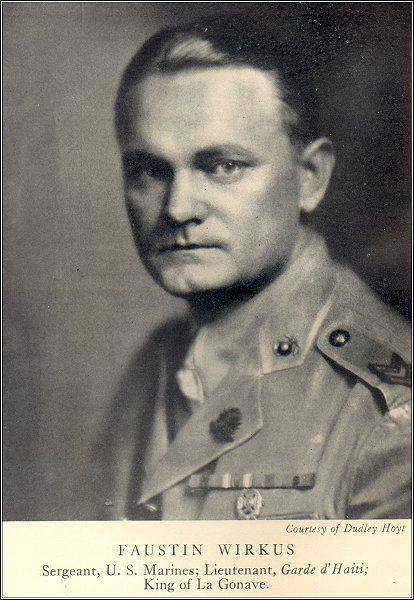 Faustin Virkus, who served in Port-au-Prince and, precisely, who was engaged in patrolling the streets, became interested in the history of this exotic country of Haiti. Most of the young marine was interested in the island of Gonav. This is one of the small Caribbean islands near the island of Haiti itself, which was part of the Republic of Haiti. Unlike the neighboring island of Tortuga, Gonav is an inhabited island and currently there are about 100 thousands of Haitians living here. The periphery of the Haitian Republic, the island of Gonaw even more preserved the Afro-Caribbean flavor. In particular, the voodoo cult was very widespread here. Faustin Virkus, who was trying to figure out what constitutes vooduism, filed a report on the transfer to Gonav Island, but he was not lucky - soon after submitting the report, he broke his arm and in November 1916 was sent to the US for treatment. When the health of Virkus returned to normal, he continued to serve - but in Cuba. There he again broke his arm and again went to the United States for treatment in a naval hospital. In 1919, Faustin Virkus, who by this time was given the rank of sergeant, was again transferred to Haiti. The young sergeant was appointed commander of the detachment of the Haitian gendarmerie, which included the US Marines. This detachment was stationed in Perodin district and was responsible for the protection of public order and the suppression of the speeches of local residents. Among his subordinates, Vircus earned respect with his courage and ability to shoot straight. On account of the sergeant by this time there were a lot of killed rebels and criminals.
Faustin Virkus, who served in Port-au-Prince and, precisely, who was engaged in patrolling the streets, became interested in the history of this exotic country of Haiti. Most of the young marine was interested in the island of Gonav. This is one of the small Caribbean islands near the island of Haiti itself, which was part of the Republic of Haiti. Unlike the neighboring island of Tortuga, Gonav is an inhabited island and currently there are about 100 thousands of Haitians living here. The periphery of the Haitian Republic, the island of Gonaw even more preserved the Afro-Caribbean flavor. In particular, the voodoo cult was very widespread here. Faustin Virkus, who was trying to figure out what constitutes vooduism, filed a report on the transfer to Gonav Island, but he was not lucky - soon after submitting the report, he broke his arm and in November 1916 was sent to the US for treatment. When the health of Virkus returned to normal, he continued to serve - but in Cuba. There he again broke his arm and again went to the United States for treatment in a naval hospital. In 1919, Faustin Virkus, who by this time was given the rank of sergeant, was again transferred to Haiti. The young sergeant was appointed commander of the detachment of the Haitian gendarmerie, which included the US Marines. This detachment was stationed in Perodin district and was responsible for the protection of public order and the suppression of the speeches of local residents. Among his subordinates, Vircus earned respect with his courage and ability to shoot straight. On account of the sergeant by this time there were a lot of killed rebels and criminals. In 1919, riots began again in Haiti. They were associated with the adoption of the new Constitution of the Haitian Republic a year before, in accordance with which foreign companies and citizens received the right to own real estate and land plots in Haiti, legally enshrined the possibility of the presence of American troops in the country. Dissatisfied with the new constitution, the Haitian nationalists revolted, led by a dismissed Haitian army officer, Charlemagne Peralte. Soon the army commanded by Peralta reached thousands of people in 40. The government of Dartigenava was not able to cope with the rebels without the involvement of additional forces in the form of US Marines. In October, 1919 troops of Charlemagne Peralt surrounded Port-au-Prince and attempted to overthrow President Dartigens. It was necessary to act the American marines, which with the support of the Haitian gendarmerie defeated the rebels. Charlemagne Peralt was captured and executed. However, clashes with the rebels continued after his death. Throughout the year, gendarmerie and US marines carried out a sweep of the countryside, identified rebels and sympathizers. In the process of fighting the rebels, 13 killed thousands of people and only to the new 1920, the insurgency in Haiti was finally crushed. The American occupying authorities made every effort to suppress the insurgency and eradicate national liberation ideas in Haiti. Great irritation in the occupation regime caused the popularity of voodoo cults, the followers of which made up the bulk of the rebels. Americans considered Voodooism a destructive and dangerous cult, which can only be dealt with in a repressive way.
Voodoo - African Caribbean Cults
Here it is necessary to tell what is Haitian Voodooism. First, the voodoo cult in Haiti is only a regional variety of Afro-Caribbean cults, rooted in the traditional belief system of the peoples of the coast of West Africa. Until now, voodoo has been practiced by African Ewe people (live in the south and east of Ghana and in the south and in the center of Togo), Kabie, land mine and background (South and Central Tog and Benin), Yoruba (South-West Nigeria). Representatives of these peoples most often were captured by slave traders on the coast, then transported to the islands of the Caribbean. The territory of modern Benin and Togo before the slave trade ban was known to Europeans as the Slave Coast. One of the centers of the slave trade was the city of Ouida (Vida), which today belongs to the state of Benin. In 1680, the Portuguese built a trading post and fortress in Ouidah, but then left them. Only in 1721, forty years later, did the Portuguese re-establish the fort, which was called “San Joan Baptista de Ajuda” - “Fort St. John the Baptist in Ajud”. The Portuguese fort became the center of the slave trade on the Slave Coast. Moreover, the key role in the slave trade was played by the Africans themselves - local leaders organized raids into the depths of Dahomey, where they seized slaves and resold them to the Portuguese. The latter, in turn, carried live goods across the Atlantic to the islands of the Caribbean. In addition to the Portuguese, there were French, Dutch, and British slave traders on the Slave Coast. By the way, it is Wuida today who is the center of voodoo worship in the territory of modern Benin. On the islands of the Caribbean, the voodoo cult penetrated along with its bearers - slaves captured on the Slave Coast. It is the Haitian variation of the voodoo cult that has received the world's greatest fame and is considered the most orthodox branch of the cult. In Haiti, a voodoo cult formed in the 18th century, as a result of the merger of African voodooism, brought by black slaves, with Catholicism. After independence, Haiti was virtually isolated from European cultural influence - after all, the white minority hastily left the island, new European merchants, planters and missionaries did not appear on the island, as a result of which Haiti’s cultural life developed independently.
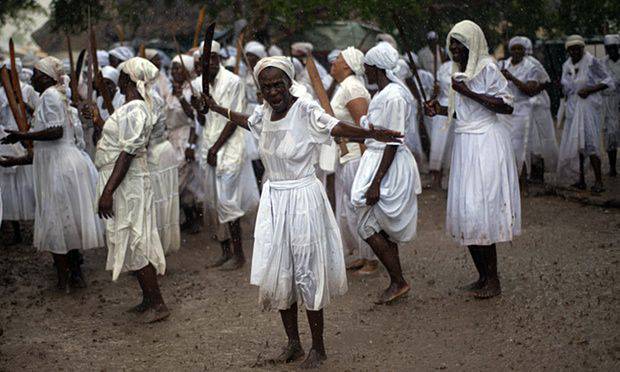
Haitian voodooism united the African and Christian components, with the majority of the voodoists formally remaining in the congregation of the Roman Catholic Church. After all, in 1860, the city of Haiti proclaimed Catholicism the state religion. It is significant that in the cult of voodoo Christian components play a secondary role. Followers of the cult worship "loa" - deities of Dagomean origin, communication with which is considered in voodooism as the goal of a person in the process of finding inner harmony. Loa help people in exchange for sacrifices. Another category honored in voodoo - “Hun” - ancestral spirits and deities, originating from the Moon Mountains region at the junction of the borders of Uganda and Rwanda. Voodoo cults are very complex for the uninitiated. Adherents of Voodooism are divided into Ungans - priests and laity. The laity, in turn, are divided into neophytes and "kantstso" - ordained to the sacraments. Most common in voodoo sacrificing roosters, rooster blood is used for ceremonies. There are rumors about human sacrifice, but they are not confirmed by religious scholars, although it is also impossible to exclude the possibility of such sacrifices, especially in Africa or in remote areas of Haiti. Voodoo rituals are sent in "Hunfor" - large huts with shelters, inside which are placed altars with voodoo and Christian symbols. In the center of the hut there is a "mitan" - a pillar, considered to be the "dear of the gods", along which the "loa" descend to people during the service. The cult ceremony itself consists in feeding the “loa” - the sacrifice of various animals. “Loa” allegedly moves into the voodooist who has fallen into a state of trance, after which the priest asks the latter all sorts of questions. Services are held to the music of ritual drums. According to voodoo artists, man has two souls, two natures. The first - “a big kind angel” - lies at the base of a person’s intellectual and emotional life. The second, the “little good angel”, serves as the basis for the “loa” that dwells in man. The voodoo priest, according to voodoo myths, can instill the soul of a “big good angel” in the body of a dead person.
The priests of voodoo cults play a huge role in the cultural life of the African Caribbean population. In spite of the fact that there is no internal hierarchy in the layer of priests, there are the most dedicated priests - “mom-list” and “papa-list”, as well as priests, who take initiation from senior priests. The people of Haiti turn to voodoo priests for advice in all areas, including medicine or legal proceedings. Although 98% Haitians are officially considered to be Christians, in reality, a huge number of people in the country profess Voodooism. At present, there are voodooists, according to some data, about 5 million people - about half of the population of the republic. In 2003, the voodooist achieved recognition of voodoo as the official religion of the Republic of Haiti along with Catholicism. On the island of Gonav the voodoo cult had a special distribution. In 1919, voodoo riots also occurred here. At the head of the local voodoo wrestlers stood Queen Ti Memenn, who was considered the informal sovereign of the African population of the island. As the American occupying authorities struggled with the worship of voodoo, they decided to arrest the “queen” Ti Memenn, for which they sent several marines led by sergeant Faustin Virkus to the island of Gonava. The sergeant’s duties included the arrest of the “queen” and her transfer to Port-au-Prince for trial and subsequent imprisonment in a local prison. Faustin Virkus coped with the mission, after which he continued to serve in the garrison of the marines in Port-au-Prince. He had not yet anticipated how much the meeting with the “queen” Ti Memenn would change his future life. Five subsequent years, Sergeant Faustin Virkus spent in Port-au-Prince, performing the usual official functions.
During this time, certain changes took place in the life of Haiti. At 1922, Mr. Philip Sydra Dartigenava replaced Haiti’s president, Louis Borno, the former foreign minister of Haiti, who represented the well-to-do mulatto elite of the country. Formerly, at the beginning of the twentieth century, Borno had already served as foreign minister, but was dismissed after he refused to promote the policy of the United States of America to completely subordinate the Haitian financial system to American interests. Borno convinced the American administration of the island to help the republic in solving economic problems. At the same time, Haiti’s foreign debt in the period under review was equal to the country's four-year budget. In order to pay off debt, Borno took a multi-million dollar loan. However, we must pay tribute to him, the situation in the country during the years of his rule really improved a little. So, 1700 kilometers of roads that have become suitable for car traffic were repaired. The authorities organized the construction of 189 bridges, built hospitals and schools, and conducted water pipelines in major cities. Moreover, in Port-au-Prince, the first city in Latin America, an automatic telephone station appeared. Agrotechnical and zootechnical personnel for the Haitian agricultural sector began to be trained at the Central School of Agriculture. In pursuing a policy aimed at improving the living conditions and enhancing the culture of Haitian society, Louis Borno paid great attention to strengthening the position of the Roman Catholic Church in Haiti. Thus, he organized a network of Catholic schools throughout the country, enlisting the support of the Vatican and rightly believing that with the help of the church he would be able to increase literacy and, accordingly, the welfare of the Haitian population. Naturally, Borno did not approve of the spread of voodoo cults in Haiti, which dragged the island’s population into the past and alienated it from European civilization.
Emperor Fausten Suluk
In 1925, the dream of Sergeant Virkus's marine came true. Faustin Virkus received a long-awaited appointment to the island of Gonav - the district administrator. Just at that time, the “queen”, T. Memenn, returned to the island. However, surprisingly, she did not organize a new protest movement, but announced to the islanders that the new administrator, a sergeant of the American marines, Faustin Virkus, is none other than the reincarnation of the former emperor of Haiti, Fausten I. It was a question of Haitian politics and General Fausten-Eli Suluke (1782-1867), who for two years (1847-1849) was president of Haiti, and then proclaimed himself emperor and for ten years (1849-1859) ruled the Haitian empire. By origin, Fausten-Eli Suluk was a slave. His parents, representatives of the West African nationality Mandinka, were brought to work on the plantations of the French colony of Santo Domingo, as Haiti was called before independence. After the beginning of the struggle for independence, Eli Suluk joined the Haitian army and served under the command of such renowned generals as Alexander Petion and Jean-Baptiste Richet. In independent Haiti, Suluk made a fairly successful military career. After President Jean-Pierre Boyer was overthrown in 1843 and expressed the interests of wealthy mulattoes, a war broke out between mulattoes and blacks in Haiti.
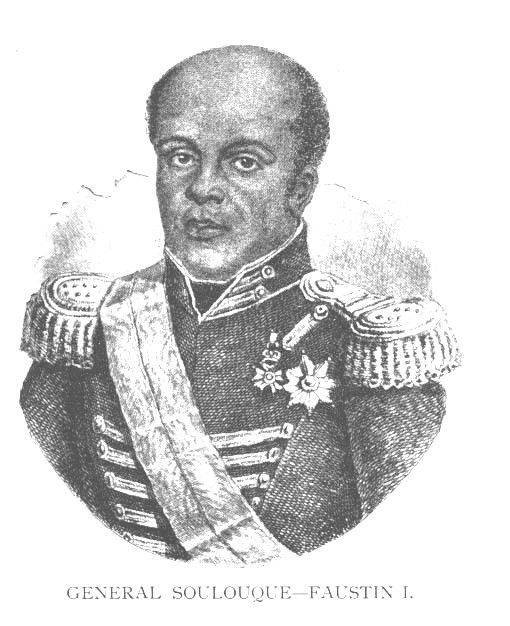
When Jean-Baptiste Richet, who replaced Boyer, died in 1847, Fostan-Eli Suluk was elected his successor. Since Suluk was a Negro, the mulatto elite believed that with his help they would be able to calm down the embittered Negro masses, and Suluk himself, in turn, would be an obedient tool in the hands of mulatto planters and merchants. But mulatto miscalculated. Suluk removed the mulattos from the leadership of the country and enlisted the support of blacks - generals of the Haitian army. The rich mulattos partly fled the country, partly underwent arrests and even cruel executions.
In pursuing a tough authoritarian policy, Suluk relied on the armed forces and on the militant Zinglin formations, created in the manner of a national guard. Apparently, the presidency of Suluk was not enough - the 67-year-old general was a very ambitious man and saw himself as the monarch of Haiti. 26 August 1849. He proclaimed Haiti an empire, and himself the emperor of Haiti under the name of Fausten I. As the treasury did not have money at that time, the first crown of Fausten I was made of cardboard covered with gilding. However, 18 on April 1852, Mr. Fausten I was truly crowned. This time, the world's most expensive crown made of pure gold, diamonds, emeralds and other precious stones was hoisted on his head. The crown was made to order in France, from there the ermine mantles were brought for the emperor and empress. The coronation ceremony of Suluk was modeled on the coronation of Napoleon Bonaparte and Josephine Beauharnais. At the end of the ceremony, Suluk shouted “Long live freedom!” Several times, although the freedom with respect to “Suluk” Haiti could be talked to an even lower degree than with respect to Napoleonic France.
During the reign of Suluk, life in Haiti, which had been quite difficult before, acquired the features of an absurd theater or even a circus. Across Port-au-Prince, posters were hung depicting the seventy-year-old emperor sitting on the lap of the Virgin Mary. His closest associates, Suluk proclaimed nobles, attempting to form a "Haitian aristocracy." He distributed noble titles and francised surnames, thinking little of the true meaning of the French words, which he made the basis for noble titles. So, in Haiti appeared "Count Antrekot", "Count Vermicelli" and other "aristocrats" with the names of the menu of a French restaurant, in which Emperor Suluk loved to dine. He formed his own national guard, in which the form was adopted, resembling the form of the Scottish guards of the English king. In particular, the guardsmen wore huge fur hats, the fur for the manufacture of which was purchased in Russia. In France, shakos and uniforms were purchased for units of the Haitian army. For the Haitian climate, the soldiers' fur hats were a very dubious invention. But when Haiti entered the war with the neighboring Dominican Republic and lost it in the years of Suluk’s rule, Suluk declared defeat a victory and even built several monuments dedicated to the “great victory of the empire over the bloodthirsty enemy”. Of course, Suluk ponabrail a large number of loans that are directed solely to the provision of his imperial court, the maintenance of the guard, the construction of monuments, the organization of balls and invited parties.
Suluk himself ruled with pathos, worthy of the rulers of the greatest world powers. However, the world more perceived the Haitian emperor as a jester, and his name became a household name. In France, where at about the same time, Louis Bonaparte proclaimed himself emperor under the name of Napoleon III, the opposition called the latter only as Suluk, emphasizing the parallels with the Haitian self-proclaimed monarch. Suluka was often painted by French artists - caricaturists. In the end, the policy of the “emperor”, which contributed to aggravating the already difficult economic situation in Haiti, led to discontent among the military. The conspirators were led by General Fabre Geffrard (1806-1878) - one of the veterans of the Haitian army, who gained popularity thanks to the heroic participation in the wars with San Domingo. Suluk was very concerned about the growing popularity of General Jeffrar and was going to organize an assassination attempt on the latter, but the general was ahead of the elderly emperor. As a result of the coup, organized in 1859 by a group of officers of the Haitian army, Fostan Suluk was overthrown. However, he lived for quite a long time and died only in 1867, at the age of 84. Fabre Jeffrard became president of Haiti.
On the throne of King Gonava
Meanwhile, among the part of the Haitian population, especially the Negroes, Fausten-Eli Suluk enjoyed great prestige and after his overthrow in Haiti, cults began to spread, in which the “emperor Fausten” took the place of one of the deities. Such a cult was spread on the island of Gonav. In the evening of 18 on July 1926, US Navy Marine Corps Sergeant Faustin Virkus was crowned on the island of Gonav under the name of Fausten II. Obviously, in the proclamation of Sergeant Virkus as the reincarnation of Emperor Suluk, who died almost two decades before the birth of the boy Faustin in Poland, the similarity of the names played a certain role. But one should also not forget about sober calculation - perhaps, the “queen” Ti Memenn believed that by proclaiming the American administrator “King Gonava”, she could achieve for her fellow countrymen an increase in welfare and an overall improvement in living conditions. By the way, the Negro priestess was right. Indeed, under the leadership of Faustin Virkus, Gonav became the best administrative district of Haiti. The duties of Virkus, in addition to the management of the district, included the leadership of the island police and the command of local troops of 28 soldiers, who were supposed to protect public order on the island with a population of thousands of people. In addition, Virkus collected taxes, checked tax returns and even performed judicial functions - that is, he actually carried out all the management of the Gonav. During the administration of the island, Virkus organized the construction of several schools and even built a small airport, which contributed to an overall improvement in the living conditions of the islanders and led to an even greater increase in the authority and popularity of Virkus among the Gonau population.
- "King Gonav" Faustin Virkus and Ti Memenn
Since Virkus had the title of a voodoo king, despite the white color of his skin, the inhabitants of the island obeyed without question. In turn, Virkus used his position for in-depth study of voodoo rituals, in which he personally participated. However, the activities of Virkus gave his command a lot of trouble. The Haitian leadership regarded the proclamation of the American sergeant as king of the island of Gonav very negatively, because they saw in this an attempt on the territorial integrity of the republic and feared that sooner or later Virkus, relying on his voodoo fans, would overthrow the power in Port-au-Prince and he would become the country's leader . The Haitian government has repeatedly stressed at meetings with representatives of the US military command the undesirability of Virkus’s activities on Gonave Island. The Haitian leadership was particularly active in demanding a solution to the issue with Vircus after the President of Haiti, Louis Borno, visited Gonave Island in 1928 and was personally convinced of the situation. Finally, in 1929, Faustin Virkus was transferred to further service in Port-au-Prince, and in February, 1931 of the former “voodoo king” was generally fired from American military service. In 1934, US troops were finally withdrawn from the territory of Haiti. This was preceded by the decision of Franklin Roosevelt on the ineffectiveness of the contingent’s presence on the island, after which, from 6 to 15 in August 1934, the US Marine Corps and the US military police were withdrawn from the Republic of Haiti. The “most African” state of the Caribbean is left alone with its political, social and economic problems.
The story of the proclamation of the American non-commissioned officer as the King of the Haitian Voodoo could not be ignored by journalists and writers. William Sibruk published the book “The Island of Magic,” in which he spoke about Faustin Virkus. After the book was published, readers' letters began to arrive, the answer to which was the publication in the same 1931 of the autobiographical book “The White King of Gonava”. Circulations of this work reached 10 million copies. After the publication of the book in the United States began a kind of "boom" of voodoo religion. Faustin Virkus traveled around the states with lectures on Caribbean culture and voodoo religion, becoming a recognized American society expert in Haiti and Haitian society. As a consultant, Virkus participated in the production of the documentary film “Voodoo” in 1933. This film, as the name suggests, was devoted to the religion and culture of the Haitian voodooists. However, like any “boom”, American citizens' interest in Haiti and voodoo soon began to subside and Vircus could no longer earn a living from lectures on Afro-Caribbean culture and fees. He engaged in gambling and selling insurance, virtually disappearing from the political and cultural life of American society. Only in 1938 did the mention of Faustin Virkus appear in American newspapers - he called on the American government to launch an intervention against the dictator of the Dominican Republic Trujillo, which borders Haiti. In 1939, the city of Faustin Virkus, despite the 43 age, decided to return to service in the marines - obviously, his financial affairs were going really badly. He began serving as the head of a recruiting office in New Ark in New Jersey, and in 1942 he was transferred to the headquarters of the Marine Corps in Washington, and later to the Marine Corps Training Center in Chapel Hill. 8 October 1945 Faustin Virkus died after a long illness and was buried at Arlington National Cemetery. He was only 48 years old. Today, the name of Faustin Virkus is almost forgotten, the majority of publications devoted to his interesting and, in some way, unique life, exist in Polish.
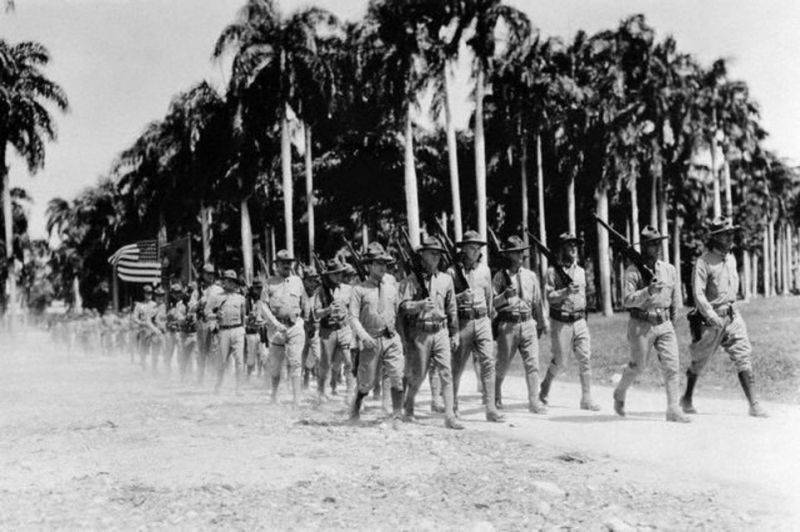
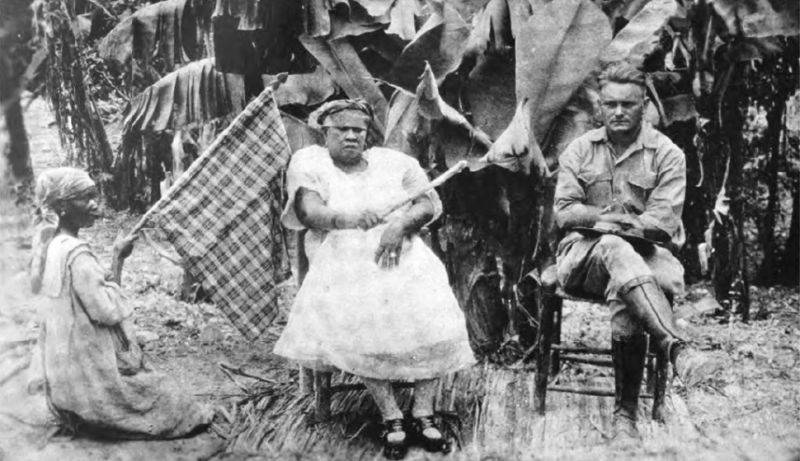
Information